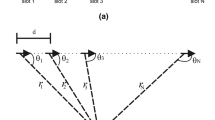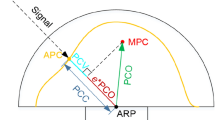Abstract
A positioning system in confined environments is not only used for entertainment, but also for other applications, such as security and safety, where it has become a priority. On the other hand, radiating cables have been successfully used to provide coverage in these harsh environments. This paper presents the evaluation of an alternative use of radiating cables for indoor positioning. Specifically, the mean delay and received power are used as measurable variables for position determination, using the location error for evaluating the goodness of such methods in two different scenarios. The first scenario is inside a tunnel where a theoretical evaluation is carried out by considering the cable as an array of magnetic dipoles. For the second scenario, the radiating cable is considered to be inside a building where a theoretical and an experimental evaluation is performed. The experimental demonstration is based on wideband measurements of channel frequency responses inside the building. Channel impulse responses are generated considering the environment, and various channel characteristics are used for positioning, i.e., decreased signal strength and multipath propagation. Fingerprinting is used to determine position, and its implementation promises to be a feasible option for indoor positioning, specifically in venues where traditional positioning systems do not work properly and the radiating cable characteristics can be exploited, i.e., corridors, mines, production lines in factories, airports, tunnels, etc.










Similar content being viewed by others
References
Farid Z, Nordin R, Ismail M (2013) Recent advances in wireless indoor localization techniques and system. J Comput Netw Commun 2013:1–12
Gu Y, Lo A, Niemegeers I (2009) A survey of indoor positioning systems for wireless personal networks. IEEE Commun Surv Tutorials 11(1):13–32
Liu H, Darabi H, Banerjee P, Liu J (2007) Survey of wireless indoor positioning techniques and systems. IEEE Trans Syst Man Cybern 37(6):1067–1080
Bensky A (2008) Wireless positioning technologies and applications. Artech House, Norwood
Weber M, Birkel U, Collmann R, Engelbrecht J (2010) Comparison of various method for indoor RF fingerprinting using leaky feeder cable. In: Proceedings of the 7th Workshop on Positioning Navigation and Communication, March 11-12, 291-298, Dresden
Engelbrecht J, Collmann R, Birkel U, Weber M (2011) First results of a leaky coaxial cable prototype for indoor positioning. In: Proceedings of the Wireless Telecommunications Symposium, April 13–15, 1–5, New York City
Engelbrecht J, Collmann R, Birkel U (2010) Methodical leaky feeder design for indoor positioning considering multipath environments. In: Proceeding of the Radio and Wireless Symposium, Jan 10–14, 164–167, New Orleans
Nishikawa K, Higashino T, Tsukamoto K, Komaki S (2008) A new position detection method using leaky coaxial cable. IEICE Electronics Express 5(8):285–290
Serezhina M, Moschevikin A, Evmenchikov R, Sikora A (2015) Using radiating cable for time-of-flight CSS measurements indoors and outdoors. In: Proceedings of the 8th IEEE International Conference on Intelligent Data Acquisition and Advanced Computing Systems: Technology and Applications, September 24–26, Warsaw
Liénard M, Degauque P (1999) Wideband analysis of propagation along radiating cables in tunnels. Radio Sci 34(1):113–122
Pereira F, Theis C, Moreira A, Ricardo M (2012) Multi-technology RF fingerprinting with leaky-feeder in underground tunnels. In: Proceeding of the International conference on Indoor Positioning and Indoor Navigation, November 13–15, Sidney
Nerguizian C, Despins C, Affes S (2006) Geolocation in mines with an impulse response fingerprinting technique and neural networks. IEEE Trans Wirel Commun 5(3):603–611
Jin Y, Soh W, Wong W (2010) Indoor localization with channel impulse response based fingerprinting and nonparametric regression. IEEE Trans Wirel Commun 9(3):1120–1127
Seseña-Osorio JA, Aragón-Zavala A, Castañon-Ávila GA (2017) Experimental study of the delay spread in an indoor radiating cable system. Wirel Pers Commun 98(1):897–927
Cao H, Zhang YP (1999) Radio propagation along a radiated mode leaky coaxial cable in tunnels. In: Proceeding of the Asia Pacific Microwave Conference, November 30–December 3, 270–271, Singapore
He R, Ai b, Wang G, Guan K, Zhong Z, Molisch AF, Briso-Rodríguez C, Oestges CP (2016) High-Speed railway communications from GSM-R to LTE-R. IEEE Veh Technol Mag 11(3):49–58
Pahlavan K (2005) Wireless information networks. Wiley, Hoboken
Valera MS, Sanchez MG (2001) RMS delay and coherence bandwidth measurements in indoor radio channels in the UHF band. IEEE Trans Veh Technol 50(2):515–525
Pérez F, Mariño P (2008) Modeling the wireless propagation channel a simulation approach with MATLAB. Wiley, Chichester
Pirkl RJ, Durgin GD (2008) Optimal sliding correlator channel sounder design. IEEE Trans Wirel Commun 7(9):3488–3497
Acknowledgements
The authors would like to thank the Mexican Consejo Nacional de Ciencia y Tecnología (CONACYT) for the postdoctoral fellowship (CVU Number 207016).
Author information
Authors and Affiliations
Corresponding authors
Ethics declarations
Conflict of interest
The authors declare that they have no conflict of interest.
Rights and permissions
About this article
Cite this article
Seseña-Osorio, J.A., Aragón-Zavala, A. & Castañon-Ávila, G.A. Indoor positioning based on a radiating cable system: a theoretical and experimental evaluation. Ann. Telecommun. 73, 777–786 (2018). https://doi.org/10.1007/s12243-018-0665-0
Received:
Accepted:
Published:
Issue Date:
DOI: https://doi.org/10.1007/s12243-018-0665-0




